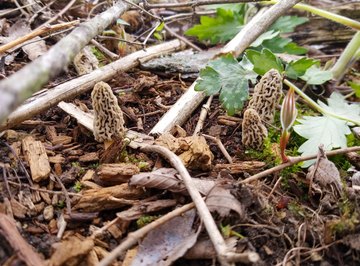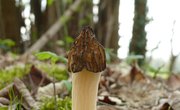
The spongy, cone- or egg-shaped mushrooms called morels rank among the most highly coveted of foraged fungi. Their rich, nutty flavor – downright heavenly after sauteing in butter – has won them many fans among everyday eaters and professional chefs alike. With its diverse hardwood forests, Indiana is prime morel country. At the height of the spring mushroom season, you can sometimes find a genuine bonanza under certain broadleaf trees or snags. The most important ingredients for successful Hoosier State morel-hunting? Patience and practice.
Identifying the Morel
The taxonomy of edible mushrooms can be confusing, but experts recognize at least three main species of morels native to Indiana: the yellow, black and half-free. Because some varieties of mushroom are unpalatable or outright poisonous, it’s best to study up on morel identification with a reputable guidebook or a mycologist or experienced mushroom hunter. That said, morels as a group are fairly easy to recognize with their heavily pitted caps, often calling to mind gnome hats, perched on thick stalks. Color varies with species and mushroom condition. Yellow morels are indeed generally tawny, black morels a rusty-brown or black, while half-free morels – named for their small, overhanging tops – range from light to dark brown.
Morel-Hunting Season
The appearance of the morels’ above ground fruiting bodies depends on spring temperatures. They typically begin sprouting in Indiana in mid-to-late April and can usually be found throughout most of May. The earliest morels, unsurprisingly, tend to pop up in southern Indiana. Colloquial wisdom suggests many different “phenological” clues (the timing of seasonal biological processes) for the start of morel season, such as the gobbling of wild turkeys or the blooming of may apple. These indicators aren't as reliable as the proper weather conditions. Morels commonly appear when topsoil temperatures reach about 55 to 57 degrees Fahrenheit. This often corresponds with daytime highs in the 60s and nighttime lows of 40 degrees or warmer. Early in the season, you may have luck on exposed south-facing hillsides; later in the spring, morels flourish on cooler northern aspects.
Searching for Morels
Morels can emerge in surprising places – even in suburban lawns. Hardwood forests and woodlands, though, are more typical haunts. In Indiana, some of the choicest morel spots are around the bases of dead American elms – not hard to find in many mixed woods given the extent of Dutch elm disease. In addition to those big elm snags, you may have luck around other dead or dying trees such as cottonwoods or apples. Tree species often associated with morels in Indiana include tulip trees, aspen, ash, oaks and occasionally white pine. At the broader habitat scale, the Indiana Department of Natural Resources notes that beech-maple forests make fertile morel-hunting grounds.
Tips and Strategies
Morels aren’t easy to spot. Their drab color serves as camouflage against the mud and leaf litter of springtime woods. After you spot one, though, you’ll have a search image in your mind that can make further hunting much easier. A good general strategy is to scout likely settings – mixed-hardwood forests, old apple orchards – until you find a morel. Scour intensively around that spot. If there’s one mushroom, more are likely in the vicinity. Then, expand your search to other locations with the same basic setting and habitat. A stick or trekking pole comes in handy for lifting or brushing aside undergrowth during your search. Some morel hunters use pocketknives to slice off the mushroom near the base, but your fingers can do the trick just fine. Given you're typically scouring for 'shrooms off-trail, you'll want to keep an eye out for poison ivy and ticks while foraging.
Where to Hunt
You can hunt morels on many of Indiana’s public lands, including the extensive Hoosier National Forest. State parks, reservoirs and forests usually allow mushroom-hunting as long as it’s not for commercial sale. The usual rules about sticking to designated trails are typically waived for the pursuit, although you should still tread lightly and follow "Leave No Trace" practices as much as possible. No matter what, it’s best to get in touch with the overseeing agency of the area you’re hoping to target – state-managed lands included – in case special restrictions exist. Some wildlife refuges and preserves don’t allow mushrooming. Private lands are another option many morel-hunters take advantage of, but it’s essential to ask permission of the landowner beforehand.
References
Resources
Tips
- Morels are a hard to find mushroom and many hunters come back empty handed. Morels can bloom overnight so don't give up after an unsuccessful search.
- When finding Morels, only take the mushroom; leaving the roots in the soil.
- Morels can sometimes be found on hillsides, in pastures, along creek beds, backyards and along roadways .
Warnings
- Some mushrooms are poisonous. First time Morel hunters should verify the mushrooms with an experienced hunter.
About the Author
Ethan Shaw is an independent naturalist and freelance outdoors/nature writer based in Oregon. He holds a B.S. in Wildlife Ecology and a graduate certificate in G.I.S. from the University of Wisconsin-Madison. His primary interests from both a fieldwork and writing perspective include landscape ecology, geomorphology, the classification of ecosystems, biogeography, wildlife/habitat relationships, and historical ecology. He’s written for a variety of outlets, including Earth Touch News, RootsRated, Backpacker, Terrain.org, and Atlas Obscura, and is presently working on a field guide.
